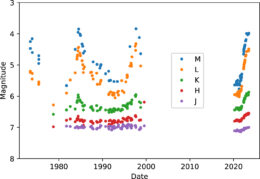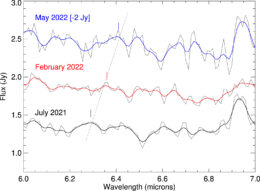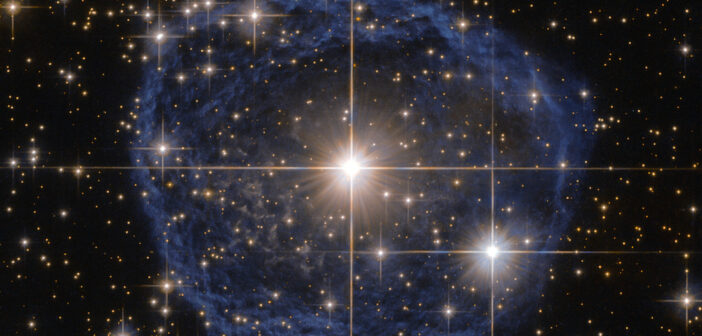The universe is a surprisingly dusty place. New research takes a look at a rare system where massive stars make dust in their powerful winds.
Stardust Gets Its Start
Cosmic dust is typically born in the atmospheres of evolved stars, where it’s cool enough for carbon and silicon to condense into solid grains. A more dramatic example of dust creation can be seen in the binary system WR 137, where the clashing stellar winds of two massive stars create dust every time the stars approach each other.

The dusty ejecta of Wolf–Rayet stars makes for fantastic images. These stars will eventually explode as supernovae. [NASA, ESA, CSA, STScI, Webb ERO Production Team]
As these stars draw near each other every 13 years, the Wolf–Rayet star’s intense stellar winds (at 4.5 million miles per hour!) pummel the O star’s disk, creating a perfect environment for making dust.

Infrared light curves of WR 137 showing four brightness increases due to dust production. Click to enlarge. [Peatt et al. 2023]
When Stellar Winds Collide
Past observations show an increase in WR 137’s infrared brightness every 13 years. Because dust grains absorb light of many wavelengths and re-emit it in the infrared, this periodic increase in infrared light suggests that there is a periodic increase in dust formation as well. The next flurry of dust formation should happen in 2024, so a team led by Megan Peatt (Embry-Riddle Aeronautical University) seized the opportunity to observe the system at infrared wavelengths using the Stratospheric Observatory For Infrared Astronomy (SOFIA), which has now been decommissioned.
The observations, made in July 2021, February 2022, and May 2022, show a steady increase in infrared emission, marking the increase in dust production as the stars approach each other. In addition to the characteristic spectral lines from the Wolf–Rayet star’s powerful winds, the team also identified a weak emission line around 6.3–6.4 microns (1 micron = 10-6 meter). This feature grew stronger as the system brightened, suggesting that it’s linked to the formation of dust.
Signs of Dust Composition?

Vertically offset spectra showing the slight migration of the 6.2-micron feature. Click to enlarge. [Peatt et al. 2023]
This might happen because as the stars draw close, the carbon-rich, hydrogen-poor wind of the Wolf–Rayet star collides and mixes with the hydrogen-rich disk around the O star. As dust production begins, there are ample hydrogen atoms to be wrapped into dust molecules, but as it continues, the proportion of wind material to disk material rises, meaning fewer hydrogen atoms are available. The team emphasizes that this result is speculative, and we’ll need more observations of WR 137 to understand how it makes dust. Hopefully, we’ll learn more about this cosmic dust factory as it nears peak production in 2024!
Citation
“FORCASTing the Spectroscopic Dust Properties of the WC+O Binary WR 137 with SOFIA,” Megan J. Peatt et al 2023 ApJ 956 109. doi:10.3847/1538-4357/acf201

